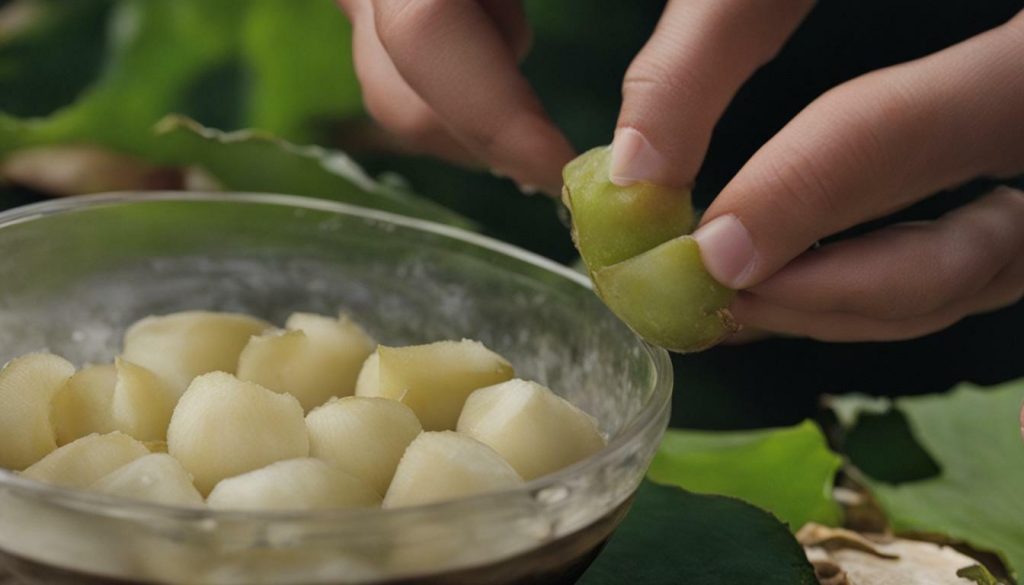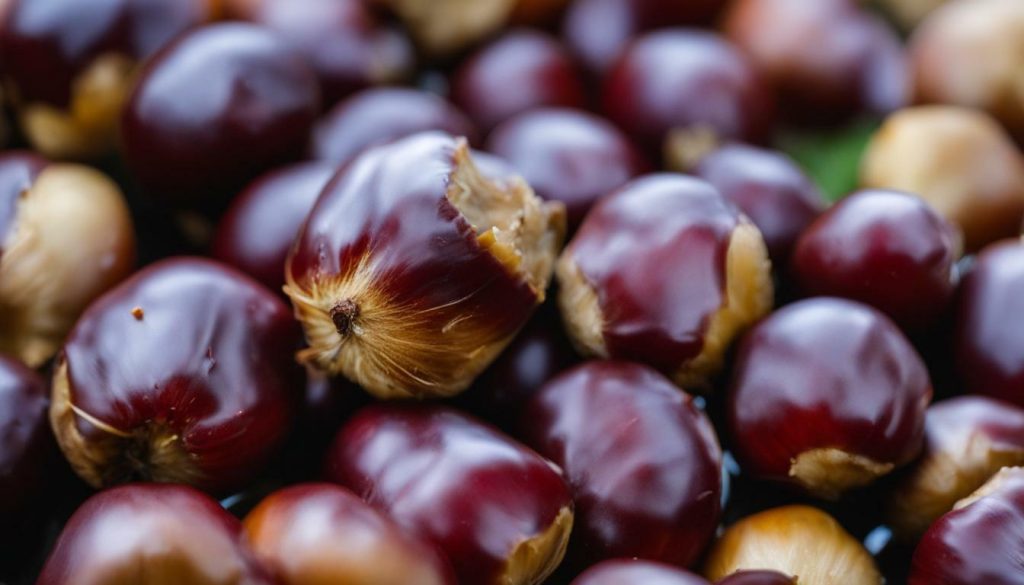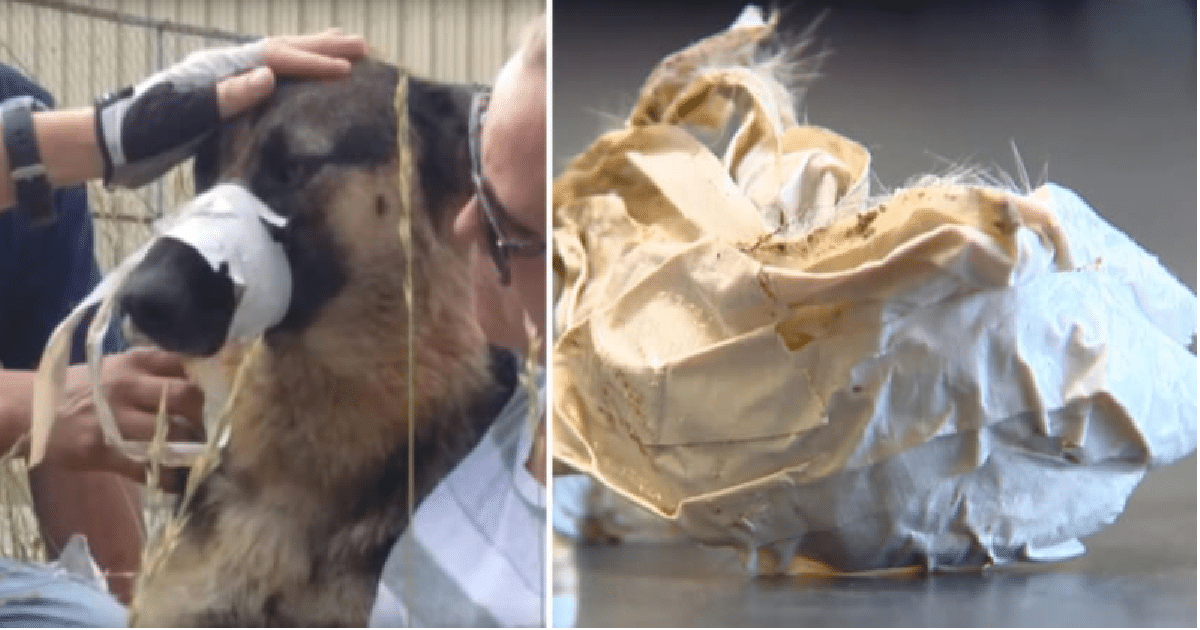
If you’re wondering whether dogs can eat water chestnuts, you’ve come to the right place. In this guide, we will explore the safety and nutritional aspects of including water chestnuts in your pet’s diet.
Key Takeaways:
- Water chestnuts can be a healthy addition to your dog’s diet, as they are high in potassium, vitamin B6, vitamin C, and omega-3 fatty acids.
- Avoid giving your dog canned water chestnuts, as they are high in sodium.
- Raw water chestnuts are safe for dogs to eat, but make sure to peel off the outer skin to avoid choking hazards.
- Water chestnut seeds are not recommended for dogs.
- Always consult with your veterinarian before introducing new foods to your dog’s diet.
Now that we’ve covered the basics, let’s delve into the nutritional benefits of water chestnuts for dogs in the next section.
The Nutritional Benefits of Water Chestnuts for Dogs
Water chestnuts offer several nutritional benefits for dogs, making them a potentially great addition to their diet. These crunchy and flavorful tubers are rich in potassium, which is essential for maintaining healthy muscle function and normal blood pressure. Additionally, water chestnuts contain vitamin B6, a nutrient that helps support brain development and function in dogs.
Another important nutrient found in water chestnuts is vitamin C, which plays a crucial role in immune function and collagen production. This vitamin helps strengthen your dog’s immune system and promotes healthy skin and coat. Furthermore, water chestnuts are a good source of omega-3 fatty acids, which can help reduce inflammation and support cardiovascular health in dogs.
Incorporating water chestnuts into your dog’s diet can provide them with added fiber, promoting healthy digestion. The fiber content in water chestnuts helps regulate bowel movements and can aid in preventing constipation. Additionally, the low calorie and fat content of water chestnuts make them a suitable option for dogs on weight management or calorie-restricted diets.

Remember, it is essential to give water chestnuts to your furry friend in moderation. While they offer numerous nutritional benefits, they should not be the primary component of your dog’s diet. Always consult with your veterinarian before introducing new foods into your dog’s diet, especially if they have any specific health concerns or dietary restrictions.
Feeding Water Chestnuts to Dogs: Dos and Don’ts
While water chestnuts can be a nutritious treat for dogs, it’s important to follow certain guidelines when feeding them to your furry companion. Water chestnuts are rich in potassium and other beneficial nutrients such as vitamin B6, vitamin C, and omega-3 fatty acids. However, it is crucial to exercise caution and take necessary precautions to ensure the safety and well-being of your dog.
When introducing water chestnuts into your dog’s diet, it is recommended to offer them in moderation. While they can provide health benefits, too much of any food can upset your dog’s digestive system. Additionally, be mindful of the sodium content in canned water chestnuts. It is best to opt for fresh, raw water chestnuts as they contain significantly lower levels of sodium.
Before feeding water chestnuts to your dog, make sure to peel off the outer skin. The skin is not edible and can pose a choking hazard. By removing the outer layer, you eliminate any potential risks and ensure that your dog can safely enjoy the crunchy texture and taste of the water chestnut.
It is important to note that water chestnut seeds are not commonly consumed by humans and are not recommended for dogs either. These seeds may be harder to digest and can cause gastrointestinal issues. It is always advisable to consult with your veterinarian before introducing any new food into your dog’s diet to ensure it is appropriate for their specific needs and health condition.

| Dos | Don’ts |
|---|---|
|
|
Remember, your veterinarian is the best resource for tailored advice regarding your dog’s diet. They can guide you on portion sizes, frequency, and any specific considerations based on your dog’s individual needs. By following these dos and don’ts, you can safely include water chestnuts as an occasional treat in your dog’s balanced diet.
Canned Water Chestnuts: A Cautionary Note
Although water chestnuts can be a healthy addition to your dog’s diet, it’s important to avoid giving them canned water chestnuts. Canned water chestnuts often contain high levels of sodium, which can be harmful to your furry friend. Excessive sodium intake can lead to dehydration, high blood pressure, and other health issues in dogs.
Instead, opt for fresh, raw water chestnuts. These can provide a crunchy and nutritious treat for your dog. They are a good source of potassium, which supports healthy muscle function, and vitamin B6, which aids in metabolism and hormone regulation. Water chestnuts also contain vitamin C, which helps boost the immune system, and omega-3 fatty acids, which promote a healthy coat and skin.
When feeding water chestnuts to your dog, it is important to remove the outer skin before offering them as a snack. The skin of water chestnuts is not edible and can pose a choking hazard. Peel the skin carefully and ensure that your dog is not given any skin to prevent any potential issues.
As with any new food, it’s crucial to consult with your veterinarian before introducing water chestnuts to your dog’s diet. They can provide guidance based on your dog’s specific needs and dietary requirements. Additionally, always monitor your dog for any adverse reactions after consuming water chestnuts, such as diarrhea, vomiting, or allergic symptoms. If any concerns arise, seek veterinary assistance promptly. By following these precautions, you can safely incorporate water chestnuts into your dog’s nutritional plan and provide them with a tasty and healthy treat option.

When including water chestnuts in your dog’s diet, make sure to peel off the outer skin, as it can pose a choking hazard. While water chestnuts themselves are safe for dogs to eat, the tough and fibrous skin is not edible and could cause your furry friend to choke or experience digestive issues. It is important to remove the skin before offering water chestnuts as a treat or adding them to your dog’s meals.
Peeling the outer skin of water chestnuts is relatively easy. Begin by rinsing them under cold water to remove any dirt or debris. Then, using a sharp knife or a vegetable peeler, carefully remove the skin by making a small incision and gently pulling it away. Take your time and be cautious to avoid any injuries. Once the skin is completely removed, the water chestnuts are ready to be sliced, diced, or served whole to your dog.

By taking the necessary precaution of peeling the outer skin, you can ensure that your dog enjoys the nutritional benefits of water chestnuts without any potential risks. Remember, moderation is key when introducing new foods to your pet’s diet. Always consult with your veterinarian before making any changes to their eating habits, as they will be able to provide personalized advice based on your dog’s specific needs and health condition. By following these safety guidelines, you can add variety and nutrition to your dog’s meals while keeping their safety a top priority.
Water Chestnut Seeds: Not Recommended for Dogs
While water chestnuts themselves are safe for dogs to eat, it’s important to note that the seeds should not be part of their diet. Water chestnut seeds are not commonly consumed by humans, and the same applies to our furry friends. It’s best to avoid letting your dog eat the seeds, as they can pose a potential choking hazard or gastrointestinal blockage.
Water chestnut seeds are small and hard, making them difficult for dogs to chew and digest properly. Ingesting these seeds can lead to discomfort, digestive issues, or even more serious health problems. It’s always better to err on the side of caution and keep your dog’s diet free from any potential risks.
When offering water chestnuts to your dog, it’s essential to peel off the outer skin. This outer layer is not edible and can be a choking hazard for dogs. By removing the skin, you’ll ensure that your dog can safely enjoy the delicious and crunchy texture of water chestnuts without any risks.

“Water chestnuts are a nutritious addition to your dog’s diet, but remember to avoid the seeds and always remove the outer skin before feeding them. Your dog’s health and well-being should be your top priority.
Summary
Water chestnuts can provide a variety of health benefits for your dog, as they are rich in essential nutrients. However, it’s crucial to follow some precautions to ensure your dog’s safety. Avoid giving them the seeds, as they can lead to digestive issues or choking hazards. Peel the outer skin before feeding water chestnuts to your dog to prevent any potential risks. Always consult with your veterinarian before introducing new foods into your dog’s diet and monitor for any adverse reactions.
| Do | Don’t |
|---|---|
|
|
Consulting Your Veterinarian: The Importance of Expert Advice
Before adding water chestnuts to your dog’s diet, it’s crucial to consult with your veterinarian to ensure their safety and suitability. While water chestnuts can provide nutritional benefits to your furry friend, it’s always best to seek professional advice specific to your dog’s health and dietary needs.
Your veterinarian will be able to assess whether your dog has any underlying health conditions or allergies that may be affected by the introduction of water chestnuts. They can provide personalized guidance on proper portion sizes and frequency of feeding, ensuring that your dog’s overall nutritional requirements are met.
Additionally, your veterinarian can address any concerns you may have regarding the potential risks associated with feeding water chestnuts to your dog. They can provide valuable insights about the dos and don’ts of introducing this exotic fruit into their diet, helping you make informed decisions about your pet’s well-being.
Remember, your veterinarian is the ultimate authority when it comes to your dog’s health and nutrition. They have the knowledge and expertise to guide you in making the best choices for your furry friend, so don’t hesitate to reach out to them before making any dietary changes.
Expert Advice for your Dog’s Well-being
As a pet owner, you play a critical role in ensuring your dog’s well-being. By consulting with your veterinarian, you can provide your dog with the care they deserve and make informed decisions about their dietary choices. Remember, every dog is unique, and what works for one may not work for another. So, before you share water chestnuts with your canine companion, consult with your veterinarian for expert advice tailored to your dog’s individual needs.

| Points to Consider | Benefits | Risks |
|---|---|---|
| Consult Your Veterinarian | – Ensure safety and suitability | – Identify potential health issues |
| Proper Portion Sizes | – Meet nutritional requirements | – Avoid overfeeding |
| Avoid Canned Water Chestnuts | – Lower sodium intake | – High sodium content |
| Peeling the Outer Skin | – Prevent choking hazards | – Inedible skin |
| No Water Chestnut Seeds | – Avoid potential risks | – Not commonly consumed |
Monitoring for Adverse Reactions
While water chestnuts are generally safe for dogs, it’s essential to monitor your pet for any adverse reactions to ensure their well-being. Every dog is unique, and some may have sensitivities or allergies to certain foods, including water chestnuts. Symptoms of adverse reactions can vary but may include gastrointestinal upset, such as vomiting or diarrhea, as well as itching, swelling, or difficulty breathing. If you notice any of these signs after feeding your dog water chestnuts, it’s important to contact your veterinarian for guidance.
To better understand the potential risks and benefits of water chestnuts for your dog, here are some key points to keep in mind:
- Introduce water chestnuts gradually: Start by giving a small amount to see how your dog reacts. If they tolerate it well, you can gradually increase the portion size.
- Observe your dog’s digestion: Pay attention to how your dog’s digestive system responds to water chestnuts. If you notice any signs of gastrointestinal upset, it’s a sign that their system may not be able to handle this food.
- Consider your dog’s overall diet: Water chestnuts should not replace a balanced and nutritious diet. They can be a healthy addition as an occasional treat or part of a well-rounded meal plan.
- Consult with your veterinarian: Before adding water chestnuts or any new food to your dog’s diet, consult with your veterinarian. They can provide personalized advice based on your dog’s specific needs and health conditions.
By carefully monitoring your dog and seeking professional guidance, you can ensure that water chestnuts are a safe and enjoyable addition to their diet. Remember, every dog is different, so what works for one may not work for another. Always prioritize your pet’s well-being and make informed decisions regarding their nutrition.

| Benefits of Water Chestnuts for Dogs | Potential Risks of Water Chestnuts for Dogs |
|---|---|
| High in potassium | Potential gastrointestinal upset |
| Rich in vitamin B6 and vitamin C | Allergy or sensitivity to water chestnuts |
| Contains omega-3 fatty acids | Possible choking hazard if not peeled |
Exploring Other Healthy Treat Options for Dogs
If you’re looking to expand your dog’s treat options, there are plenty of other healthy and safe alternatives to water chestnuts that you can consider. These alternatives provide a variety of flavors and nutrients that can complement your dog’s diet.
One option is to incorporate other exotic fruits into your dog’s treat rotation. Fruits like blueberries, strawberries, and bananas are not only delicious but also packed with vitamins and antioxidants that can support your dog’s overall health. Just remember to remove any seeds or pits and cut the fruit into appropriate-sized pieces to prevent choking hazards.

Another idea is to explore the world of crunchy vegetables. Carrots, green beans, and cucumbers make excellent low-calorie treats that can help satisfy your dog’s chewing needs. These vegetables are also a great source of fiber and vitamins. As always, be mindful of portion sizes and adjust them according to your dog’s size and dietary needs.
Table: Comparison of Exotic Fruits and Vegetables
| Fruits | Benefits |
|---|---|
| Blueberries | Rich in antioxidants and vitamins |
| Strawberries | High in vitamin C and fiber |
| Bananas | Good source of potassium and vitamin B6 |
| Carrots | Crunchy and rich in beta-carotene |
| Green Beans | Low-calorie and high in fiber |
| Cucumbers | Refreshingly hydrating and low in calories |
Remember, variety is key when it comes to treating your dog. By offering a range of fruits and vegetables, you can provide different flavors and nutrients that contribute to your dog’s overall well-being.
However, it’s essential to remember that treats should only make up a small portion of your dog’s diet. The majority of their nutrition should come from a balanced and complete dog food. Always consult with your veterinarian before introducing new foods to your dog’s diet, especially if your dog has any specific dietary restrictions or health conditions.
Conclusion
In conclusion, water chestnuts can be a nutritious addition to your dog’s diet, but it’s important to follow guidelines, consult with your veterinarian, and monitor for any adverse reactions.
Water chestnuts, which are actually vegetable tubers, can provide various health benefits to your furry friend. They are rich in potassium, vitamin B6, vitamin C, and omega-3 fatty acids, making them a healthy choice for dogs. However, it’s crucial to offer them in moderation and avoid giving canned water chestnuts to your pet due to their high sodium content.
When feeding water chestnuts to your dog, always ensure they are fresh and raw. Remove the outer skin as it is not edible and could pose a choking hazard. It’s also important to note that water chestnut seeds are not recommended for dogs, as they are not commonly consumed by humans either.
Prior to introducing water chestnuts or any new food into your dog’s diet, it’s essential to consult with your veterinarian. They can provide expert advice on whether water chestnuts are suitable for your dog and ensure their overall health and well-being.
Remember to monitor your dog for any adverse reactions after introducing water chestnuts into their diet. If you notice any unusual symptoms or discomfort, seek veterinary assistance promptly.
FAQ
Can dogs safely eat water chestnuts?
Yes, dogs can safely eat water chestnuts in moderation.
What are the nutritional benefits of water chestnuts for dogs?
Water chestnuts are high in potassium, vitamin B6, vitamin C, and omega-3 fatty acids, providing various health benefits for dogs.
How should water chestnuts be fed to dogs?
Water chestnuts should be given in moderation, and the outer skin should be peeled off before feeding to avoid choking hazards.
Are canned water chestnuts safe for dogs?
It is not recommended to give dogs canned water chestnuts due to their high sodium content. Fresh, raw water chestnuts are the preferred choice.
Can dogs eat water chestnut seeds?
Water chestnut seeds are not commonly consumed by humans and are also not recommended for dogs.
Why is it important to consult a veterinarian before introducing water chestnuts to a dog’s diet?
Consulting a veterinarian ensures the safety and well-being of your dog when introducing new foods, including water chestnuts.
What should pet owners look out for in terms of adverse reactions when feeding water chestnuts to dogs?
Pet owners should monitor for any signs of adverse reactions such as vomiting, diarrhea, or allergic reactions and should seek veterinary assistance if necessary.
Can dogs be fed other healthy treats besides water chestnuts?
Yes, there are other healthy treat options for dogs, including other exotic fruits that provide similar nutritional benefits as water chestnuts.






